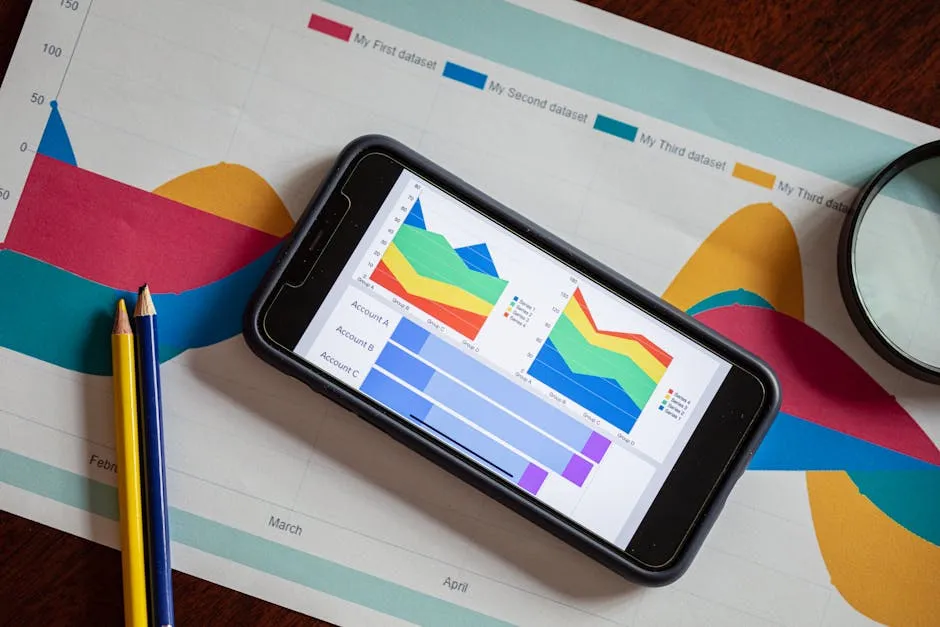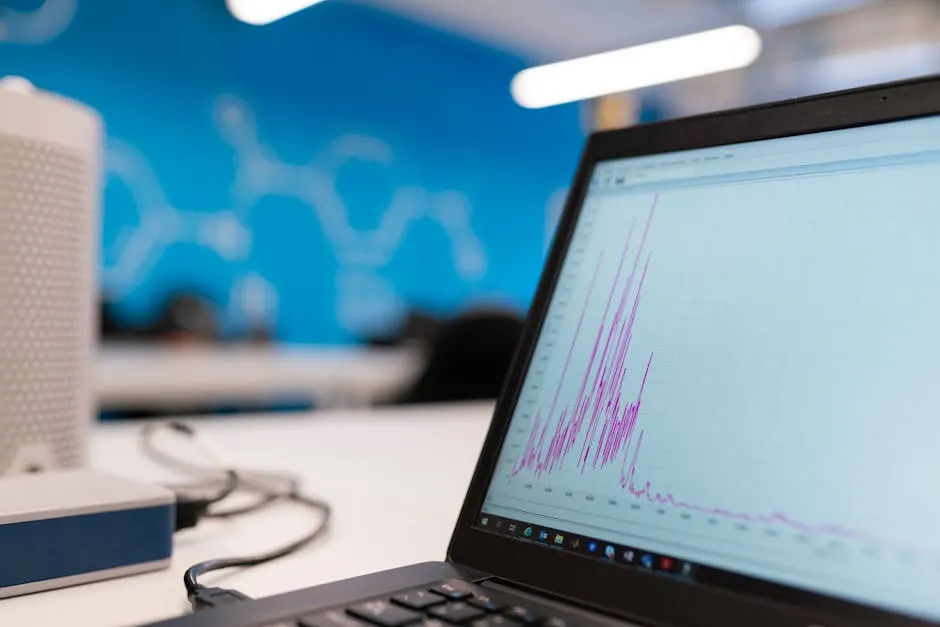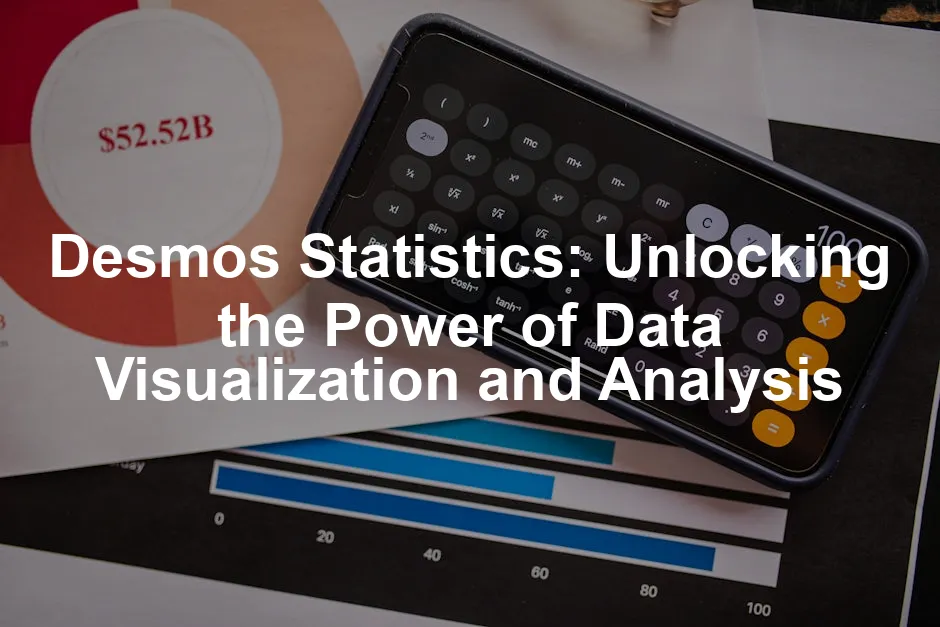Introduction
In a world awash with data, the ability to analyze and interpret statistics is a superpower. Enter Desmos, a dynamic graphing calculator that makes statistics not only accessible but also engaging. This tool transforms the often dry realm of numbers into a vibrant playground for students and educators alike. Imagine a classroom where statistics isn’t just a subject but an adventure. With Desmos, students can see the impact of their data in real-time, making learning both interactive and fun.
Whether you’re a student grappling with the concepts of mean and median or a teacher on a quest to demystify standard deviation, Desmos has your back. It provides a plethora of functions that simplify complex statistical ideas. You can visualize data through interactive graphs and charts, which allows users to grasp abstract concepts with ease. This blog post will showcase the various statistical functions available in Desmos.
From basic statistical measures to advanced distributions and regression analysis, it’s all here! The journey through Desmos will empower you with the knowledge to harness the full potential of this tool. You’ll uncover how to perform calculations, visualize results, and interpret data, all while having a laugh or two. So buckle up, because we’re about to embark on a thrilling ride through the world of Desmos statistics!
In this blog post, you will learn how to navigate the features of Desmos that enhance statistical understanding. We will provide you with tips for practical applications in educational settings. By the end, you will have a clearer understanding of why Desmos is a game-changer in statistics education. Get ready to elevate your statistical skills and transform how you view data!

Summary of Key Points
In this article, we’ll traverse the expansive landscape of Desmos statistics. We’ll start by introducing the basic statistical functions, including mean, median, and standard deviation, and progress to more complex statistical tests and regression analysis. You’ll discover how Desmos facilitates visualizing data through interactive graphs and charts, making learning statistics a breeze. Plus, we’ll cover some practical applications in educational settings and provide resources for educators. As we unpack these features, you’ll not only learn how to use Desmos but also why it’s a game-changer in statistics education. Are you ready to elevate your statistical skills? Let’s dive in!

Understanding Desmos Statistics
What is Desmos?
Desmos is a powerful online graphing calculator. It allows users to create, visualize, and analyze mathematical functions effortlessly. This tool has gained popularity in educational settings, transforming how students and teachers approach complex concepts. No longer are students trapped in the land of pencil and paper; with Desmos, they can engage with their graphs in real-time.
The significance of Desmos in education cannot be overstated. It empowers students to visualize data, making abstract statistical concepts tangible. Imagine plotting points on a graph and instantly seeing trends emerge. Desmos breathes life into statistics, turning what was once a daunting subject into an approachable and enjoyable experience. Whether you’re crunching numbers for a project or just curious about data trends, Desmos is your trusty sidekick.

And speaking of trusty sidekicks, every student needs a reliable Desmos Graphing Calculator to tackle those pesky math problems. It’s like having a math wizard in your pocket, ready to assist you at any moment!
Why Use Desmos for Statistics?
Using Desmos for statistical analysis offers several advantages. First, its interactivity makes learning engaging. Students can manipulate data points, adjust parameters, and witness the immediate effects on graphs. This hands-on experience fosters a deeper understanding of statistical principles.
Moreover, Desmos is user-friendly. With a simple interface, even those intimidated by technology can navigate its features. It’s like having a personal assistant for statistics that doesn’t judge your math skills. You can input data and instantly receive visual feedback without the steep learning curve associated with traditional statistical software.
When compared to conventional statistical tools, Desmos shines in its accessibility. Traditional software can be complex, often requiring extensive training or prior knowledge. In contrast, Desmos democratizes data visualization. Educators can easily integrate it into their lessons, ensuring all students have the opportunity to grasp statistical concepts.
In summary, Desmos is not just a graphing calculator; it’s a gateway to understanding statistics. It combines interactivity and ease of use, making it a preferred choice for educators and students alike. With Desmos, you’ll find that statistics is no longer a foreign language but a tool for exploration and discovery.

Basic Statistical Functions in Desmos
Key Functions and Their Uses
Mean: Calculating the average is fundamental in statistics. With Desmos, finding the mean is as simple as entering your data list. The function mean(list) provides the average, giving you a quick snapshot of your data’s central tendency. This helps students understand how individual data points relate to the whole. For further insights into the concept of mean, you can check out what does mean identically distributed in statistics.
Understanding the mean is crucial in statistics, and you can learn more about it through this what does mean identically distributed in statistics resource.
Median: The median, or the middle value in a dataset, is crucial for understanding data distribution. Desmos makes it easy to find the median using median(list). This function can highlight how outliers may affect the mean, emphasizing why the median is often a better measure of central tendency in skewed distributions. For a deeper understanding, explore the statistics poland median salary 2024.
The median is an important statistical measure, and you can find comprehensive insights about it in statistics poland median salary 2024.
Standard Deviation: Understanding variability is key in statistics. Desmos calculates standard deviation with stdev(list). This function shows how spread out the data points are from the mean. By visualizing standard deviation, students can grasp the concept of dispersion, making it clearer why some datasets vary more than others.
These basic functions are just the tip of the iceberg. Desmos offers a range of statistical tools that enhance learning and teaching. With interactive graphs and visual representations, students can visualize these concepts in action. By using Desmos, statistics becomes not only understandable but also enjoyable!

And for those who want to take their learning further, consider adding a Statistics for Dummies book to your collection. It’s like having a friendly tutor available 24/7, ready to explain those tricky concepts!
Advanced Statistical Functions
Statistical Tests
One-Sample t-Test
Let’s start with the one-sample t-test. This test helps determine if the sample mean significantly differs from a known value. It’s super useful in various fields, like psychology and education, where researchers want to compare sample data against a population mean.
To conduct a one-sample t-test in Desmos, follow these simple steps:
- Input Your Data: First, enter your data list. For example, let’s say we have test scores:
scores = [82, 90, 76, 88, 91] - Set the Hypothetical Mean: Suppose we want to test if these scores differ from a class average of 85.
- Run the t-Test: Use the function:
ttest(scores, value=85). This will yield the t-statistic and the p-value, helping you decide if the scores significantly differ from the average. - Interpret Results: If the p-value is less than your significance level (commonly 0.05), you reject the null hypothesis, suggesting a significant difference.
Feel free to visualize these results on a graph by plotting your data points alongside the class average. This visual representation adds clarity and makes the results more engaging!

Independent Two-Sample t-Test
Now, let’s tackle the independent two-sample t-test. This test compares the means of two independent groups. Think of it as a friendly face-off between two teams!
Here’s how to perform it in Desmos:
- Enter Two Data Sets: Let’s say we have two groups of scores:
group1 = [82, 90, 76, 88, 91]andgroup2 = [78, 85, 84, 80, 89] - Conduct the t-Test: Use the function:
ittest(group1, group2). This function will calculate the t-statistic and p-value for you. - Visualize the Comparison: Plot both groups on a bar graph. This visual can help highlight differences in means, making it clear which group performed better.
- Analyze Results: As before, check the p-value. A value below 0.05 indicates a significant difference between the groups, while a higher value suggests they are statistically similar.
Distributions
Common Distributions in Desmos
Understanding distributions is crucial in statistics! Desmos offers a range of distributions like normal, binomial, and Poisson. Here’s a quick overview of each:
- Normal Distribution: This bell-shaped curve is everywhere in statistics. It’s great for modeling real-world phenomena. In Desmos, you can visualize it using:
normaldist(mean=0, stdev=1) - Binomial Distribution: This distribution helps model the number of successes in a fixed number of trials. It’s perfect for scenarios like flipping coins or passing tests. You can visualize it with:
binomialdist(trials=10, p=0.5) - Poisson Distribution: This one models the number of events occurring in a fixed interval of time or space. Think of it as counting the number of cars passing through a toll booth in an hour. Visualize it with:
poissondist(mean=3)
Understanding these distributions is essential because they help inform data analysis and decision-making. When you visualize these distributions in Desmos, you can see how data is spread out, making it easier to draw conclusions.

Visualizing Distributions
Visualizing distributions takes your understanding to the next level. In Desmos, you can easily graph these distributions, allowing you to see how data points fall within each distribution. This is especially handy when teaching or presenting data.
For example, after entering the functions for the normal, binomial, and Poisson distributions, you can overlay them on the same graph. This way, you can compare their shapes and understand their properties intuitively.
By engaging with these visualizations, you’ll foster a more profound understanding of how different distributions behave. So, get creative with your data and let Desmos help you illuminate the fascinating world of statistical distributions!

Regression Analysis in Desmos
Understanding Regression
Regression analysis is a statistical method used to understand relationships between variables. It helps us make sense of data by fitting a model to it. Imagine you’re trying to predict how much popcorn you’ll need for movie night based on the number of friends joining. Regression helps you see the pattern and make informed guesses.
This method is significant because it enables us to quantify relationships. For instance, if you notice that more friends mean more popcorn, regression can help determine just how much. By fitting a model, we can estimate values and understand underlying trends in the data, making it a vital tool in statistics.

Performing Regression in Desmos
Desmos makes regression analysis straightforward and fun. Let’s break down how to perform various types of regression within this dynamic graphing calculator.
Linear Regression
Let’s kick things off with linear regression. This type of regression is used when there’s a linear relationship between two variables. Here’s how to conduct linear regression in Desmos:
- Set Up Your Data: Start by entering your data into a table. For example, you might have:
x1 = [1, 2, 3, 4, 5]andy1 = [2, 3, 5, 7, 11] - Input the Regression Model: In Desmos, type:
y1 ~ mx1 + b. Here,mrepresents the slope, andbis the y-intercept. - View Results: Desmos will immediately provide you with the best-fit line and values for
mandb. Not only that, but you can see how well the line fits your data. - Interpret: Analyze the slope to understand how
ychanges withx. A positive slope means that asxincreases,yalso increases. A negative slope does the opposite!
Let’s spice it up with an example. Imagine you’re tracking how many hours you study and your test scores. The relationship might look something like this:
- Study Hours: [1, 2, 3, 4, 5]
- Test Scores: [55, 65, 75, 85, 95]
When you run the linear regression, you’ll find a positive slope, indicating that more study hours typically lead to higher test scores.
Polynomial and Other Types of Regression
Sometimes, relationships aren’t linear. This is where polynomial regression comes into play. It fits a curve to the data, allowing for more complexity. Here’s how to do it in Desmos:
- Set Up Your Data: Let’s say you have a set of data that follows a quadratic pattern:
x1 = [1, 2, 3, 4, 5]andy1 = [1, 4, 9, 16, 25] - Input the Polynomial Model: Type in:
y1 ~ ax1^2 + bx1 + c. Here,a,b, andcare coefficients for the quadratic equation. - Visualize the Curve: Desmos will plot the best-fit curve for you. This visual representation helps you see how well the polynomial fits your data.
- Analyze: Polynomial regression is useful in situations where data trends upward or downward in a non-linear fashion. It’s great for modeling things like projectile motion or population growth.
But wait, there’s more! Desmos also supports other regression types. You can perform logistic regression, exponential regression, and more. Each type serves different purposes, so choose wisely based on your data.
In summary, Desmos makes regression analysis not only accessible but also enjoyable. Whether you’re fitting lines or curves, this tool enhances your ability to analyze data. So, grab your data sets and start predicting like a pro!

Educational Applications of Desmos Statistics
For Teachers
Teaching statistics can sometimes feel like trying to teach a cat to swim—challenging and often met with blank stares. Desmos changes the game for educators! With its interactive graphing capabilities, teachers can engage students in a way that traditional methods rarely achieve. Think of Desmos as your trusty sidekick in the classroom, ready to make statistics fun and accessible.
One of the best ways teachers can leverage Desmos is through its extensive library of resources. The Stats Medic Desmos Collection offers a treasure trove of activities tailored for teaching statistics. These activities aren’t just worksheets; they are interactive experiences designed to deepen understanding. You can find everything from basic statistical functions to complex analyses, making it easy to integrate into your lessons.
Moreover, webinars for educators provide additional support. These sessions are packed with tips on using Desmos effectively, ensuring you’re not left to fend for yourself. Whether you’re new to Desmos or a seasoned pro, these resources can enhance your teaching toolkit.
Teachers can also collaborate with the Desmos community. By sharing insights and resources, educators can continuously improve their methods. So get ready to turn your classroom into a vibrant hub of statistical exploration!

For Students
Statistics can sometimes feel like a foreign language, but with Desmos, students can finally say, “Aha! I get it!” The platform offers a unique opportunity for students to learn statistics through interactive experiences. Imagine being able to see the effect of changing data points in real-time. With Desmos, students can manipulate data and instantly visualize the results. It’s like having a superpower for understanding numbers!
The benefits of using Desmos are manifold. First, it fosters engagement. Students can explore concepts like mean, median, and standard deviation in a hands-on manner. This interactive approach keeps them invested in their learning. No more yawning in the back row!
Desmos also encourages collaboration. Students can work together on projects, sharing their insights and discoveries. This collaborative learning environment not only enhances understanding but also builds essential communication skills.
Moreover, the platform is free and accessible, allowing every student to hop on and start exploring. With Desmos, statistics transforms from a daunting subject into an exciting adventure. Goodbye, textbook fatigue; hello, data-driven fun!

Conclusion
Desmos statistics offers a wealth of tools and functions that make understanding and teaching statistics easier and more interactive. From basic functions to advanced analysis, Desmos not only simplifies statistical calculations but also enhances the learning experience. It enables both teachers and students to engage with data meaningfully and enjoyably.
As we continue to navigate a data-driven world, tools like Desmos will be essential in fostering a deeper understanding of statistics. They empower students to visualize data, encouraging critical thinking and informed decision-making. For educators, Desmos provides resources that transform traditional teaching methods into dynamic learning experiences.
So why not jump in and start exploring the fascinating world of data with Desmos today? Your students will thank you, and you might just find yourself having a little fun along the way. After all, statistics doesn’t have to be boring—it can be a thrilling ride through the vibrant landscape of numbers and insights!
Please let us know what you think about our content by leaving a comment down below!
Thank you for reading till here 🙂
And while you’re at it, why not check out some Educational Posters for Statistics? They can brighten up your classroom and make statistics feel even more alive!
All images from Pexels




